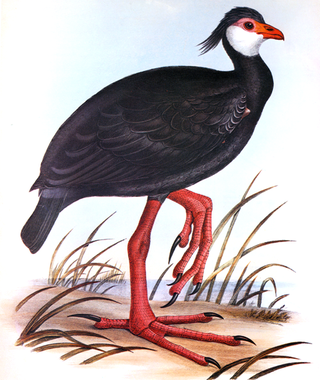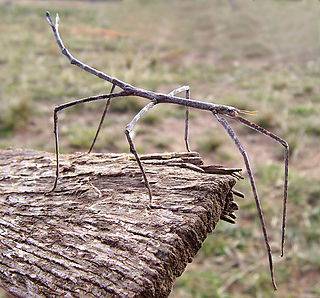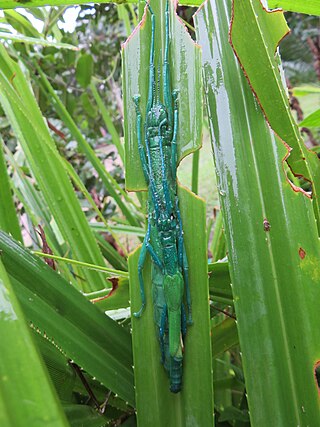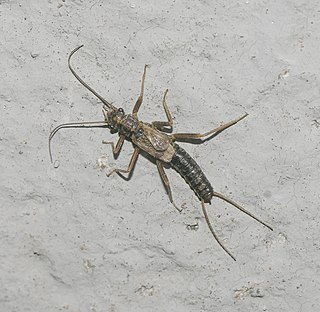
The Phasmatodea are an order of insects whose members are variously known as stick insects, stick-bugs, walkingsticks, stick animals, or bug sticks. They are also occasionally referred to as Devil's darning needles, although this name is shared by both dragonflies and crane flies. They can be generally referred to as phasmatodeans, phasmids, or ghost insects, with phasmids in the family Phylliidae called leaf insects, leaf-bugs, walking leaves, or bug leaves. The group's name is derived from the Ancient Greek φάσμα phasma, meaning an apparition or phantom, referring to their resemblance to vegetation while in fact being animals. Their natural camouflage makes them difficult for predators to detect; still, many species have one of several secondary lines of defense in the form of startle displays, spines or toxic secretions. Stick insects from the genera Phryganistria, Ctenomorpha, and Phobaeticus include the world's longest insects.

George Robert Gray was an English zoologist and author, and head of the ornithological section of the British Museum, now the Natural History Museum, in London for forty-one years. He was the younger brother of the zoologist John Edward Gray and the son of the botanist Samuel Frederick Gray.

Extatosoma tiaratum, commonly known as the spiny leaf insect, the giant prickly stick insect, Macleay's spectre, or the Australian walking stick, is a large species of Australian stick insect. The species has the Phasmid Study Group number PSG9.

Extatosoma is a genus of phasmids, in the monotypic subfamily Extatosomatinae, with two species. One occurs in Australia, one in New Guinea. Both have a colour morph imitating leaves, and one imitating lichen.

Heteropteryx is a monotypic genus of stick insects containing Heteropteryx dilatata as the only described species. and gives its name to the family of the Heteropterygidae. Their only species may be known as jungle nymph, Malaysian stick insect, Malaysian wood nymph, Malayan jungle nymph, or Malayan wood nymph and because of their size it is commonly kept in zoological institutions and private terrariums of insect lovers. It originates from the Malay Archipelago and is nocturnal.

The Euphasmatodea, also known by its junior synonym Verophasmatodea is a suborder of the Phasmatodea, which contains the vast majority of the extant species of stick and leaf insects, excluding the Timematodea. The oldest record of Euphasmatodea is Araripephasma from the Crato Formation of Brazil, dating to the Aptian stage of the Early Cretaceous.

The Phasmatidae are a family of the stick insects. They belong to the superfamily Anareolatae of suborder Verophasmatodea.

Megacrania batesii, commonly known as the peppermint stick insect, is an unusual species of stick insect found in northeastern Australia, the Bismarck Archipelago, the Solomon Islands, New Guinea, and possibly as far north as the Philippines. It is notable for its aposematic coloration, as well as its robust chemical defense mechanism. Its common name refers to the irritating fluid — with an odor resembling peppermint — that it sprays as a defensive action from a pair of glands located at its prothorax when threatened, as well as the cylindrical, twig-like shape of its body. A member of the subfamily Megacraniinae, it was first described by English naturalist and explorer Henry Walter Bates in 1865.

Eurycnema goliath, commonly known as the goliath stick insect, or the regal stick insect, is a large species of stick insect in the family Phasmatidae, endemic to Australia and considered one of the largest species of stick insects in the country. The species has the Phasmid Study Group number PSG14.
The pink-winged phasma is a species of stick insect that is endemic to Australia.

Anchiale austrotessulata, the tessellated stick insect, tessellated phasmid or tessulata stick insect, is a medium-sized, stick insect found in the Brisbane area of Australia. Fully grown males in mating season exhibit frenetic behaviour. This species is also parthenogenetic.
Ctenomorpha gargantua, the gargantuan stick insect, is a species of stick insect that is endemic to rainforests in northeastern Queensland, Australia. It is Australia's longest stick insect and among the world's longest stick insects, with females having been confirmed at up to 56.5 cm (22.2 in) in total length, including extended legs and cerci, but they can likely grow even larger, as there are unconfirmed measurements of up to 61.5 cm (24.2 in). Both sexes are brown, but males only reach about two-thirds the length of females and they are also thinner.
Phobaeticus hypharpax, is a species of phasmid or stick insect of the genus Phobaeticus. It is found in Sri Lanka and Southeast India. It is closely related to the Sri Lankan species Phobaeticus lobulatus and the Southeast Indian Phobaeticus sinetyi. It is characteristic for the sparse but very broad and prominent serrations of the anterodorsal carina of the front femora and unarmed medioventral carina of the middle and back femora. It is also distinctive for its particularly long abdomen.

Phasmatini is a tribe of stick insects in the family Phasmatidae. There are more than 40 described species, found in Australasia, and Asia

Phasmotaenia lanyuhensis is a species of stick insect, order Phasmatodea. It is endemic to Taiwan. It is often included in the family Phasmatidae, although sometimes excluded from it when the family is strictly delimited. It derives its specific name from its type locality, Lanyuh Island, commonly known as Orchid Island.

Megacrania is a genus of the subfamily Megacraniinae of stick insects. Members of this genus are commonly referred to as "peppermint stick insects", due to the characteristic odor of their defensive spray, as well as the cylindrical, twig-like shape of their bodies.

Diura is a genus of insects belonging to the family Perlodidae, subfamily Perlodinae and tribe Perlodini.

Ctenomorpha is a genus of phasmids belonging to the family Phasmatidae.

Aretaon asperrimus is a species of insect in the Aretaon genus of the Phasmatodea order. The sometimes used common name thorny stick insect is a bit misleading, since the species does not correspond to the typical stick-like habitus and many other species are thorny as well.

















